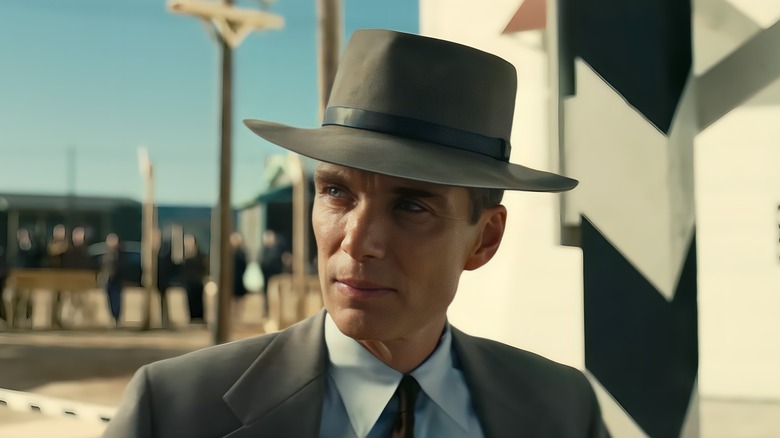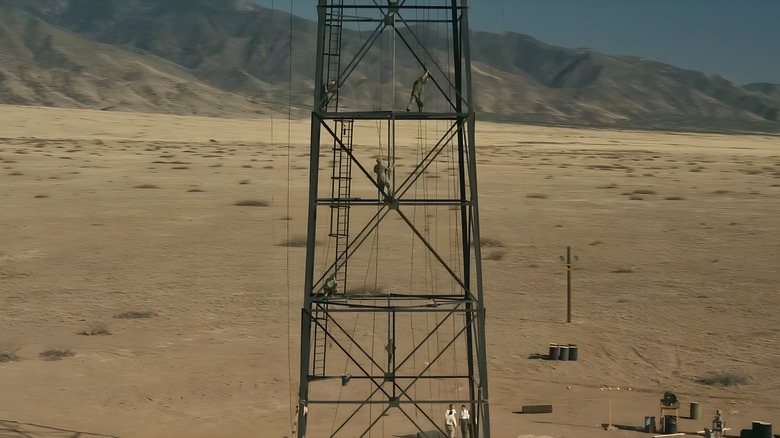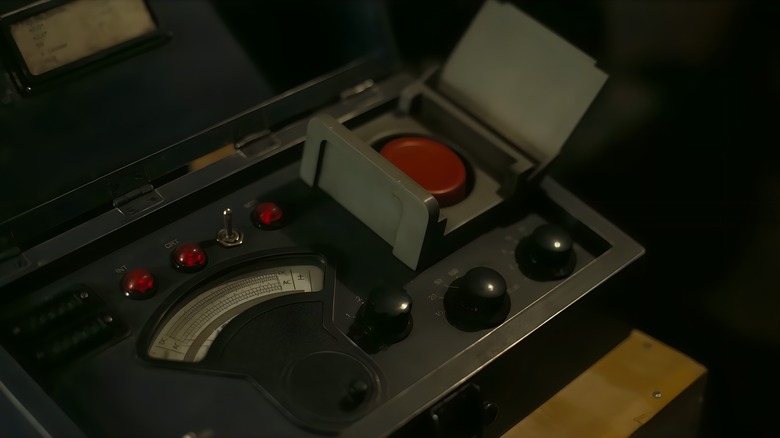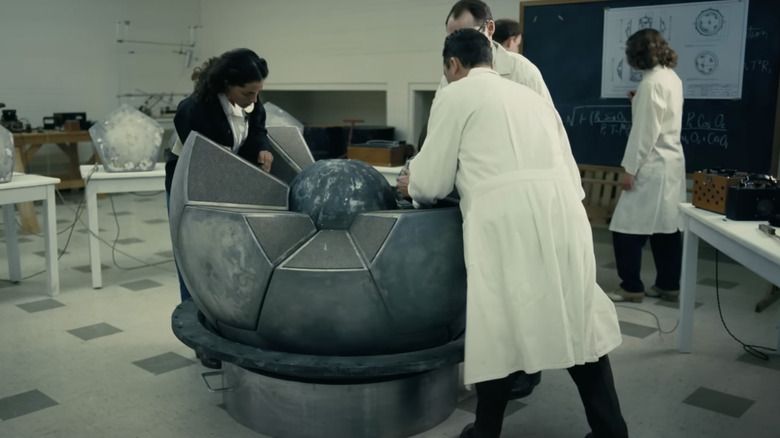Oppenheimer: The Nitty Gritty Details On How Nolan Recreated An Atomic Bomb Explosion
"Oppenheimer" has finally unleashed itself into cinemas.
Directed by Christopher Nolan, "Oppenheimer" is a unique departure for the British auteur. The film, based on the life of J. Robert Oppenheimer, is the creative's first biopic. It's also his first film with Universal Pictures — Nolan and Warner Bros. broke up after the studio decided to send their 2021 theatrical slate to streaming. While these are uncharted territories for the director, he's winning, as "Oppenheimer" is one of his best-reviewed films to date.
Looper critic Reuben Baron gave the film a positive rating of 8.5/10, praising Nolan for creating an unlikely and unrelenting blockbuster about complex themes and historical figures, writing, "Even with the length and complexity on display in 'Oppenheimer,' Nolan is a director who knows how to hold an audience's attention, whether it's in a bomb test or a political hearing." While the film is a standout because of its compelling story and rich character work, a major highlight is how "Oppenheimer" recreates an atomic bomb explosion.
In the three-hour-long epic, Nolan recreates the Trinity Test in New Mexico — the first-ever nuclear explosion. It's a key moment in the film, one that emphasizes the sheer might and scale of Oppenheimer's invention. Nolan, who is known amongst cinephiles as being anti-CGI, recreated the sequence as best as he could, and it clearly shows — especially in IMAX screens. The director would also like fans to know that he didn't detonate an actual atomic explosion. "It's flattering that people would think I would be capable of something as extreme as that on the one hand, but it's also a little bit scary," the director told The Hollywood Reporter.
How did Nolan recreate the atomic bomb explosion? Without the use of CGI.
Various experiments were conducted to make the explosion come to life
In true Christopher Nolan fashion, "Oppenheimer" does not make use of computer-generated imagery. One would assume that the director would break his rule for the extensive atomic bomb sequences but no, Nolan pushed forward with an emphasis on practical effects. Continuing his chat with The Hollywood Reporter, Nolan opened up about the importance of neglecting CGI. "CG inherently is quite comfortable to look at," Nolan said. "It's safe, anodyne. And what I said to [visual effects supervisor] Andrew [Jackson] on 'Oppenheimer' is, 'This can't be safe. It can't be comfortable to look at it. It has to have bite. It's got to be beautiful and threatening in equal measure.'"
Per The Radio Times, a number of unique methods were used to film the atomic bomb explosion. Andrew Jackson and Scott Fisher, the film's visual effects gurus, conducted a variety of experiments to create the cinematic moment. This included smashing ping pong balls together, splattering paint on walls, and lighting up magnesium. These various experiments were filmed tight and up close, in variable of framerates, giving them a larger-than-life feeling. The outlet explains that Nolan and his creative team have decided to keep explicit details about their experiments under wraps.
While speaking with IGN, Nolan opened up about a few of the experiments Fisher and the team did and the process of how they were approved. "Scott Fisher's work on the special effects, combining magnesium flares with gasoline, and black powder explosions, and things," the director revealed. "But watching the dailies, you were seeing it develop with my editing brain on [...] just start visualizing combinations, and experimenting with combinations of imagery to give the feeling of what this must have felt like to watch this," Nolan continued.
Forced perspective was used to create the explosion
In a separate interview with Empire (via SYFY), Christopher Nolan discussed how Scott Fisher's team utilized forced perspectives to capture some of the chaos they were conducting. "We do them as big as we possibly can, but we do reduce the scale so it's manageable," Nolan said. "It's getting it closer to the camera, and doing it as big as you can in the environment."
To get the most intense and realistic visuals, Nolan says the effects team used a variety of methods, which resulted in a flurry of different visual manifestations, telling IGN, "...some of what they did was absolutely tiny and magnified, sort of miniature, as it were, or even beyond that really, microscopic. And some of it was absolutely vast and required intense concentration on set." This sentiment of using practical effects also extends toward Oppenheimer's first ruminations on the quantum world and how atoms interact with one another. In the film, audiences see Oppenheimer imagine scenarios that show atoms coming together.
See the film in IMAX and audiences will see just how beautiful and threatening an atomic bomb explosion can be. Viewers should also remember how obsessed Nolan is with authenticity, telling IGN that the Trinity Test sequence was shot in New Mexico. Real bunkers and towers were built to replicate the area, resulting in an on-set tension that replicated the terror that was present during the actual test. "We're out there at night preparing for these very large-scale explosive events that have to be conducted safely and with great care," Nolan explained. The director continued by emphasizing how this led to tension and anticipation for those on set, allowing them to understand and appreciate what the real scientists went through during the real Trinity Test.
Christopher Nolan's team even made a replica of the bomb
When it comes to "Oppenheimer," there's a transparent philosophy of being hands-on and as creative as possible. While Christopher Nolan isn't averse to CGI — he notably created a nuclear explosion using computer-generated effects in 2012's "The Dark Knight Rises — it's admirable how he wants to give audiences a tactile, analog feel that transports viewers back to the '40s.
From using old-school framing techniques to creating real-life explosions using oil and magnesium, it's difficult to ignore how "Oppenheimer" is a true labor of love for those involved. In the film, what you see is what you get, meaning everything was physically created and breathed to life, including props that didn't necessarily need to be there.
While speaking with Entertainment Weekly, Nolan opened up about how the film's creatives built a real replica of an atomic bomb. The director explained how a full-sized version of the bomb wasn't needed... but production designer Ruth De Jong and special effects supervisor Scott Fisher took Nolan's no CGI rule and ran with it, ignoring the director and creating a life-size replica of the bomb for the Trinity Test sequence. "... They built the entire thing in exacting detail so that we were then free to shoot the entire process, the shrink wrapping on it as it comes up in the truck that gets cut off, the way that the different modules are inserted in and wired up," Nolan explained to EW.
Nolan may not have set off an actual nuclear explosion to recreate the Trinity Test but he and his team certainly did find inventive ways to make the sequence as life-like and terrifying as possible — all without the use of CGI. In the modern world, that's a miracle.



